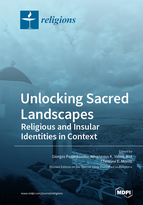Unlocking Sacred Landscapes: Religious and Insular Identities in Context
A special issue of Religions (ISSN 2077-1444).
Deadline for manuscript submissions: closed (31 December 2021) | Viewed by 38811
Special Issue Editors
Interests: mediterranean archeology; landscape archaeology; ancient religions; ancient visual and material culture; ethnoarchaeology and cultural heritage studies
Interests: historical archaeology; landscape archaeology; island archaeology; spatial analysis; Christian topography; material culture studies
Special Issue Information
Dear Colleagues,
‘Island archaeology’ emerged as a defined field during the 1970s, with many critiques and developments continuing to the present day. Historians and archaeologists have attempted to bring together issues of identities, insularities, and connectivities both in large and self-contained islands in terms of natural resources, but also in smaller island societies with limited resources. Within a wider field of rethinking the premises, agendas, and practices of island archaeology, an examination of how insularity has influenced the shape of historical events at a regional level and a focus on the domain of religion and its interaction with insularity remains a desideratum.
Inserting religion within a landscape perspective via an integrated approach, which carefully considers temporality, spatiality, and materiality, the Unlocking Sacred Landscapes Network invites historians and archaeologists to examine the function of religion in maintaining ‘social power’ (with the term including and considering both elite/official and non-elite/popular ideologies and cosmologies) in both large and smaller island societies.
This Special Issue will encompass various approaches both to ritual space and to artefacts relating to ritual practice and cult involving islandscapes (including landscapes and seascapes). The terms ritual and cult are used broadly to include sanctuaries, temples, and churches as well as the domestic and funerary spheres of life. We particularly welcome articles with a strong methodological and theoretical focus. Although the main focus of the Network is the Mediterranean region, we also warmly welcome relevant papers from colleagues working in other areas of the world, with a view to stimulating wider methodological dialogues and comparative approaches. The chronological range is also open, ranging from prehistory to the recent past and inclusive of ethnography, ethnoarchaeology, and cultural heritage studies.
In particular, we welcome contributions dealing with:
(1) Historical and culturally driven perspectives that recognize the complexities of island religious systems as well as the active role of the islanders in constructing their own religious identities, irrespective of emulation and acculturation.
(2) Inter-island and island/mainland relations, maritime connectivity of things and people, and ideological values in relation to religious change.
(3) The relation between island space and environment in the performance and maintenance of spiritual lives.
(4) The interrelation between official, popular, and personal identities, including ritual healing and magic in island societies.
(5) Phenomenological, performative, and experiential analyses related to ritual space and/or its associated material assemblages in island societies.
Dr. Giorgos Papantoniou
Dr. Athanasios K. Vionis
Dr. Christine E. Morris
Guest Editors
Manuscript Submission Information
Manuscripts should be submitted online at www.mdpi.com by registering and logging in to this website. Once you are registered, click here to go to the submission form. Manuscripts can be submitted until the deadline. All submissions that pass pre-check are peer-reviewed. Accepted papers will be published continuously in the journal (as soon as accepted) and will be listed together on the special issue website. Research articles, review articles as well as short communications are invited. For planned papers, a title and short abstract (about 100 words) can be sent to the Editorial Office for announcement on this website.
Submitted manuscripts should not have been published previously, nor be under consideration for publication elsewhere (except conference proceedings papers). All manuscripts are thoroughly refereed through a double-blind peer-review process. A guide for authors and other relevant information for submission of manuscripts is available on the Instructions for Authors page. Religions is an international peer-reviewed open access monthly journal published by MDPI.
Please visit the Instructions for Authors page before submitting a manuscript. The Article Processing Charge (APC) for publication in this open access journal is 1800 CHF (Swiss Francs). Submitted papers should be well formatted and use good English. Authors may use MDPI's English editing service prior to publication or during author revisions.
Keywords
- island societies
- sacred landscapes
- ritual and cult
- official, popular and personal religions
- visual and material culture






